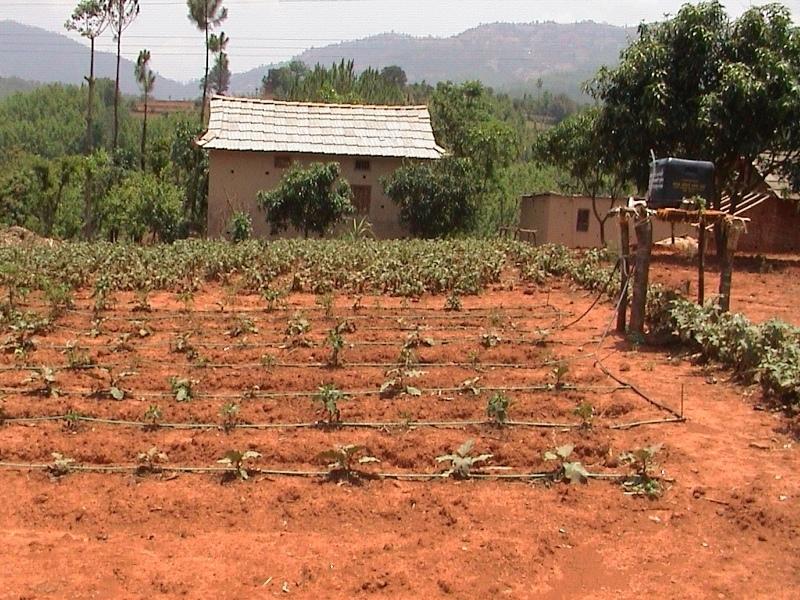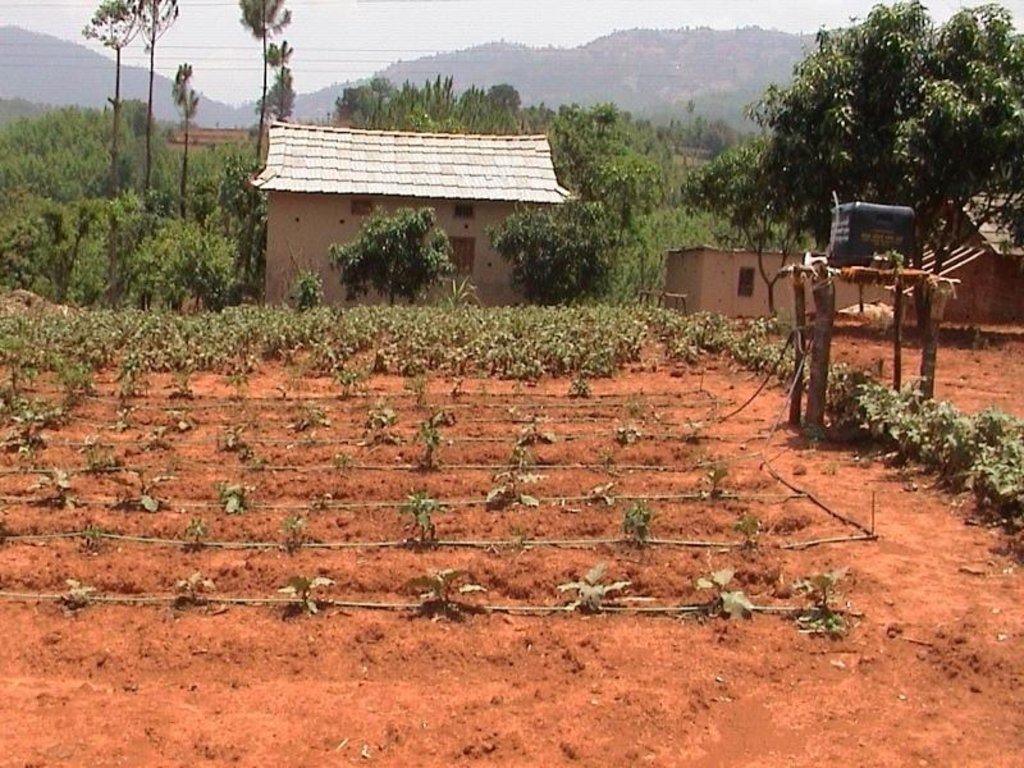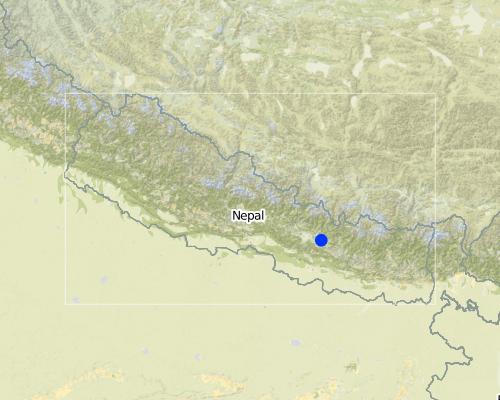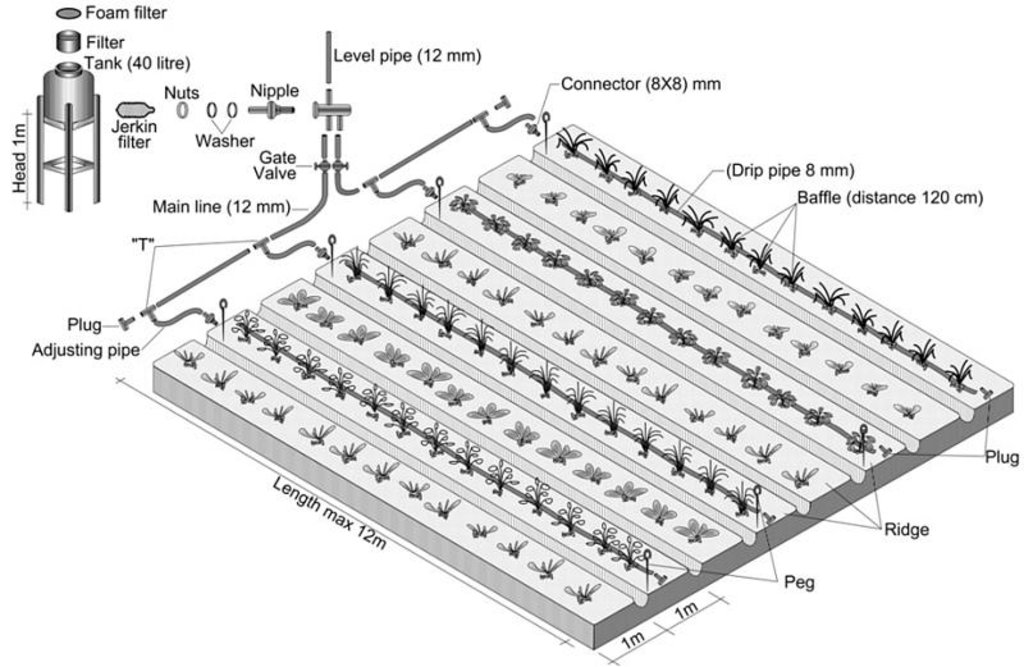Low cost drip irrigation [النيبال]
- تاريخ الإنشاء:
- تحديث:
- جامع المعلومات: Madhav Dhakal
- المحرر: –
- المُراجع: David Streiff
Thopa Sichaee (Nepali)
technologies_1501 - النيبال
عرض الأقسام
توسيع الكل طي الكل1. معلومات عامة
1.2 تفاصيل الاتصال بالأشخاص الرئيسيين لمصدر المعلومات والمؤسسات المشاركة في تقييم وتوثيق التقنية
متخصص في الإدارة المستدامة للأراضي:
متخصص في الإدارة المستدامة للأراضي:
Adhikari Krishna
977 1 5525313
PARDYP/ICIMOD
PO Box 3226, Kathmandu Nepal
النيبال
متخصص في الإدارة المستدامة للأراضي:
Shrestha-Malla Smita
977 1 5525313
sshrestha@icimod.org.np
PARDYP/ICIMOD
PO Box 3226, Kathmandu Nepal
النيبال
متخصص في الإدارة المستدامة للأراضي:
اسم المشروع الذي سهّل توثيق/تقييم التقنية (إذا كان ذلك على صلة)
People and Resource Dynamics Project, Nepal (PARDYP)اسم المؤسسة (المؤسسات) التي سهلت توثيق/تقييم التقنية (إذا كان ذلك على صلة)
ICIMOD International Centre for Integrated Mountain Development (ICIMOD) - النيبال1.3 الشروط المتعلقة باستخدام البيانات الموثقة من خلال WOCAT
متى تم تجميع البيانات (ميدانيا)؟:
13/08/2004
يوافق جامع المعلومات والشخص (لاشخاص) الرئيسي لمصدر المعلومات على الشروط المتعلقة باستخدام البيانات الموثقة من خلال WOCAT:
نعم
1.5 الإشارة إلى الاستبيان (الاستبيانات) حول مناهج الإدارة المستدامة للأراضي
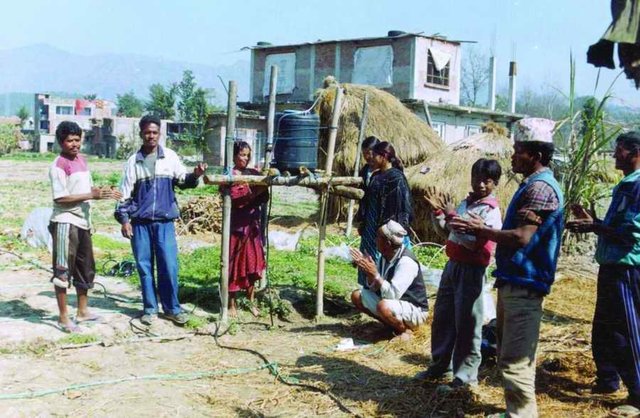
Participatory action research on drip irrigation [النيبال]
Conducting participatory action research with farmers and line agencies for demonstrating, disseminating and scaling up drip irrigation.
- جامع المعلومات: Madhav Dhakal
2. وصف تقنيةالإدارة المستدامي للأراضي
2.1 وصف مختصر للتقنية
تعريف التقنية:
An irrigation system which allows the slow and precise delivery of water to crops
2.2 وصف تفصيلي للتقنية
الوصف:
Drip irrigation is a very water-efficient irrigation system. Water is dripped to individual plant root zones at low rates (2.25 l/hr) from emitters embedded in small diameter plastic pipes.
Farmers in the Jhikhu Khola watershed, Nepal, suffer from a shortage of water for irrigation between the end of one monsoon (June to September) and the next pre-monsoon period (May). This seriously limits agricultural production and leads to much land being left fallow after the monsoon crops have been harvested. Only a small area is planted with winter crops. The sources of irrigation water (such as rivers, and streams) are limited and the amount of water they provide is inadequate for cropping. Most of the sources remain dry outside the monsoon. Farmers expend
considerable time and labour gathering what water they can to irrigate their crops. Low cost drip irrigation (LCDI) has been introduced in the watershed as a cost effective way of making the best use of the limited available water.
The cropping pattern of this area sees pre-monsoon vegetables established in February and March and winter vegetables in September and October. The low cost drip irrigation sets are installed while the fields are being prepared by ploughing, levelling, and ridging. Lateral pipes (12m long) are laid along the ridges which lie 1.5m apart. A wooden platform with storage tank is installed and connected to the lateral pipes. After the lateral pipes are laid out, planting holes are dug along the ridges spaced to coincide with the drip holes. These holes are usually set every 0.6 or 1.2m along the pipes depending on the crop. Farmyard manure and chemical fertiliser is placed in each pit and mixed well with the soil. Next, vegetable seedlings are planted in each hole and daily drip watering begins. Bitter gourd is the most commonly grown crop followed by cauliflower. Irrigation water is generally applied either in the morning or the evening. If needed, stakes are placed next to each plant a week later to allow the plants to climb. The climber crops like bitter gourd are netted one month after planting to provide more space for fruiting
Harvesting starts in mid-May and continues until September. Farmers maintain the system by repairing leaks in the pipe joints and by unblocking blocked drip holes.
2.3 صور التقنية
2.5 البلد/المنطقة/المواقع التي تم تنفيذ التقنية فيها والتي يغطيها هذا التقييم
البلد:
النيبال
المنطقة/الولاية/المحافظة:
Bagmati zone
مزيد من التفاصيل حول الموقع:
Kavepalanchowk/Jhikhu Khola watershed
Map
×2.6 تاريخ التنفيذ
في حالة عدم معرفة السنة بالتحديد، يرجى الإشارة إلى التاريخ التقريبي:
- منذ أقل من 10 سنوات (مؤخرًا)
2.7 إدخال التقنية
حدد كيف تم إدخال التقنية:
- من خلال المشاريع/ التدخلات الخارجية
التعليقات (نوع المشروع، الخ):
Concept of drip irrigation came from Israel. LCDI was introduced by IDE/Nepal
3. تصنيف تقنية الإدارة المستدامي للأراضي
3.1 الغرض الرئيسي ( الأغراض الرئيسية) للتقنية
- Reduce water input
3.2 نوع (أنواع) استخدام الأراضي الحالية حيث يتم تطبيق التقنية

الأراضي الزراعية
- زراعة سنوية
المحاصيل الرئيسية (المحاصيل النقدية والغذائية):
major cash crop: Tomato, potato, vegetables
major food crop: Rice , wheat , maize
other: Mustard, barley

مختلطة (محاصيل/ رعي/ أشجار)، بما في ذلك الحراجة الزراعية
- الحراجة الزراعية
المنتجات / الخدمات الرئيسية:
major cash crop: Tomato, potato, vegetables
major food crop: Rice , wheat , maize
other: fodder trees, fruit trees
التعليقات:
Major land use problems (compiler’s opinion): Insufficient water limits agricultural production during the winter and pre-monsoon seasons (Nov-May) leading to low farm incomes from the small landholdings. The increasing inputs of chemical fertilisers are a matter of concern for environmental protection.
Major land use problems (land users’ perception): Irrigation water shortage for the crops grown during winter and premonsoon months.
Type of cropping system and major crops comments: Rain fed land: Maiz-Wheat /vegetables. Irrigated land: Rice - vegetables/Wheat-vegetabes/ Maize
3.3 مزيد من المعلومات حول استخدام الأراضي
إمدادات المياه للأرض التي يتم تنفيذ التقنية عليها:
- بعلية
التعليقات:
Water supply: Also mixed rainfed - irrigated
عدد مواسم الزراعة في السنة:
- 3
حدد:
Longest growing period in days: 150 Longest growing period from month to month: Jun - Oct Second longest growing period in days: 120 Second longest growing period from month to month: Nov - Feb
3.4 مجموعةالإدارة المستدامة للأراضي التي تنتمي إليها هذه التقنية
- إدارة الري (بما في ذلك إمدادات المياه والصرف الصحي)
3.5 انتشار التقنية
حدد انتشار التقنية:
- منتشرة بالتساوي على مساحة
إذا كانت التقنية منتشرة بالتساوي على منطقة ما، فحدد المنطقة التقريبية المغطاة:
- < 0.1 كم2 (10 هكتار)
التعليقات:
The technology was first introduced in the Jhikhu Khola watershed ( JKW) in 1993 with the support from University of British Columbia (UBC) but due to the technical problems it stopped in the same year . The drip sets introduced for the first time was North American type, and spare parts were not available after malfunctioning. Later on , from Oct. 2000 to Jan.2001, UBC again conducted experiments using two different types of drip sets , i.e. LCDI and Western Type ( Stefanie 2002) This experiment was conducted on Cauliflower. People and Resource Dynamics Project with the collaboration of Institute of engineering , Tribhuban University has initiated the drip experiment on cauliflower in Hokse ( Kubinde) in November 1999. In 2000 and 2001 the drip experiments were conducted on bitter gourd at Horticultural center( Panchkhal). From 2001 onwards it was introduced to the farmers field.
For this study , most of the discussions will be concentrated on Bitter gourd grown under drip in Panchkhal.
3.6 التدابير التقنية في مجال إلادارة المستدامة للأراضي

التدابير الإدارية
- M2: تغيير في مستوى الإدارة/الكثافة
3.7 الأنواع الرئيسية من تدهور الأراضي التي تناولتها التقنية

تدهور المياه
- (Hs): التغيير في كمية المياه السطحية
التعليقات:
Main causes of degradation: urbanisation and infrastructure development (poor irrigation infrastructres), other natural causes (avalanches, volcanic eruptions, mud flows, highly susceptible natural resources, extreme topography, etc.) specify (uneven distribution of precipitation throughout the year.), poverty / wealth (lack of captial - limited fund allocated from government for the irrigation infrastructure development and maintenance), labour availability (lack of labour - out migration for off-farm employment), education, access to knowledge and support services (lack of knowledge - approapriate technologies and the approach to implement them)
Secondary causes of degradation: other human induced causes (specify) (agricultural causes - increased dose of agrochemical use, poor seed qality), land tenure (land subdivision - population growth , separating family members from a household.)
3.8 منع أو حد أو عكس تدهور الأراضي
تحديد هدف التقنية فيما يتعلق بتدهور الأراضي:
- الحد من تدهور الأراضي
4. المواصفات الفنية، وأنشطة التنفيذ، والمدخلات، والتكاليف
4.1 الرسم الفني للتقنية
4.2 المواصفات الفنية/شروحات الرسم الفني
Technical parts and design of a low cost drip irrigation system
Location: Jhikhu Khola watershed. Kabrepalanchowk/
Technical knowledge required for field staff / advisors: high
Technical knowledge required for land users: moderate
Main technical functions: increase / maintain water stored in soil, slow and precise delivery of water to plant root zones, enhanced phot*
Secondary technical functions: reduction of evaporation losses*, reduction of water distribution losses*
Change of land use practices / intensity level: from conventional irrigation flood/ bucket) to efficient irrigation
4.3 معلومات عامة بخصوص حساب المدخلات والتكاليف
حدد كيفية احتساب التكاليف والمدخلات:
- لكل وحدة تقنية
حدد الوحدة:
Drip irrigation system
حدد الحجم والطول وما إلى ذلك (إذا كانت ذات صلة):
150 square meter
حدد العملة المستخدمة لحساب التكاليف:
- دولار أمريكي
اذكر متوسط تكلفة أجر العمالة المستأجرة في اليوم الواحد:
2.80
4.4 أنشطة التأسيس
| النشاط | نوع التدبير | التوقيت | |
|---|---|---|---|
| 1. | Connection of the lateral pipes to the water storage tank | إدارية | February/March |
| 2. | Opening and closing of gate valves | إدارية | February/March |
| 3. | Levelling of land for uniform water distribution | إدارية | February/ March ( if required) |
| 4. | Construction of wooden platform to raise the storage tank generally | إدارية | February/March |
| 5. | Installation of lateral pipes along the ridges/beds;check the spacing | إدارية | February /March |
| 6. | then dig about 0.5m deep and 0.3m diameter planting pits for | إدارية | February/March |
4.5 التكاليف والمدخلات اللازمة للتأسيس
| تحديد المدخلات | الوحدة | الكمية | التكاليف لكل وحدة | إجمالي التكاليف لكل مدخل | % من التكاليف التي يتحملها مستخدمو الأراضي | |
|---|---|---|---|---|---|---|
| العمالة | Labour | Persons/day | 1,0 | 2,8 | 2,8 | 100,0 |
| معدات | Drip set | unit | 1,0 | 25,8 | 25,8 | |
| إجمالي تكاليف إنشاء التقنية | 28,6 | |||||
التعليقات:
Duration of establishment phase: 6 month(s)
4.6 الصيانة/الأنشطة المتكررة
| النشاط | نوع التدبير | التوقيت/الوتيرة | |
|---|---|---|---|
| 1. | Prevent leakage by replacing damaged or worn out parts | إدارية | / as per need |
| 2. | Clean the drip holes with water and a pin | إدارية | / as per need |
4.7 التكاليف والمدخلات اللازمة للصيانة/للأنشطة المتكررة (سنويًا)
| تحديد المدخلات | الوحدة | الكمية | التكاليف لكل وحدة | إجمالي التكاليف لكل مدخل | % من التكاليف التي يتحملها مستخدمو الأراضي | |
|---|---|---|---|---|---|---|
| العمالة | Cleaning drip holes | Persons/day | 1,43 | 2,8 | 4,0 | 100,0 |
| معدات | Replacing damaged parts | unit | 1,0 | 300,0 | 300,0 | 100,0 |
| إجمالي تكاليف صيانة التقنية | 304,0 | |||||
التعليقات:
Machinery/ tools: spade
The cost is calculated for 150 square meter area , and extrapolated to per hectar of land. Only costs are listed which are additional to the traditional way of growing bitter gourd with out drip. Cost estimated in 2006.
5. البيئة الطبيعية والبشرية
5.1 المناخ
هطول الأمطار السنوي
- < 250 مم
- 251- 500 ملم
- 501 - 750ملم
- 1,000-751 ملم
- 1,500-1,100 ملم
- 2,000-1,500 ملم
- 3,000-2,001 ملم
- 4,000-3,100 ملم
- > 4000 ملم
المنطقة المناخية الزراعية
- رطبة
Thermal climate class: subtropics
5.2 طوبوغرافيا
متوسط الانحدارات:
- مسطح (0-2%)
- بسيط (3-5%)
- معتدل (6-10%)
- متدحرج (11-15%)
- تلال (16-30%)
- شديدة الانحدار(31-60%)
- فائقة الانحدار (>60%)
التضاريس:
- هضاب/سهول
- أثلام مرتفعة
- المنحدرات الجبلية
- منحدرات التلال
- منحدرات في السفوح
- قاع الوادي
المنطقة الارتفاعية:
- 100-0 متر فوق سطح البحر
- 500-101 متر فوق سطح البحر
- 1,000-501 متر فوق سطح البحر
- 1,500-1,001 متر فوق سطح البحر
- 2,000-1,501 متر فوق سطح البحر
- 2,500-2,100 متر فوق سطح البحر
- 3,000-2,501 متر فوق سطح البحر
- 4,000-3,001 متر فوق سطح البحر
- > 4000 متر فوق سطح البحر
التعليقات والمواصفات الإضافية بشأن التضاريس:
Altitudinal zone: 850 m a.s.l.
5.3 التربة
متوسط عمق التربة:
- ضحل جدًا (0-20 سم)
- ضحلة (21-50 سم)
- متوسطة العمق (51-80 سم)
- عميقة (81-120 سم)
- عميقة جدًا (> 120 سم)
قوام التربة (التربة السطحية):
- متوسط ( طميي، سلتي)
المواد العضوية في التربة السطحية:
- متوسطة (1-3%)
- منخفضة (<1%)
إذا كان متاحًا، قم بإرفاق وصف كامل للتربة أو تحديد المعلومات المتوفرة، على سبيل المثال نوع التربة، الرقم الهيدروجيني/ درجة حموضة التربة، قدرة التبادل الكاتيوني، النيتروجين، الملوحة وما إلى ذلك.
Soil fertility is medium
Soil drainage / infiltration is good
Soil water storage capacity is medium
5.4 توافر المياه ونوعيتها
توافر المياه السطحية:
ضعيف/ غير متوافر
نوعية المياه (غير المعالجة):
مياه الشرب سيئة (تتطلب معالجة)
تعليقات ومواصفات أخرى بشأن نوعية المياه وكميتها:
Availability of surface water: More in rainy season (June- September), less in April/May
Water quality (untreated): Also good drinking water but poor in rainy season (June- September), less in April/May source: Natural spring
5.6 خصائص مستخدمي الأراضي الذين يطبقون التقنية
التوجه السوقي لنظام الإنتاج:
- مختلط (كفاف/ تجاري)
- تجاري/سوق
الدخل من خارج المزرعة:
- 10-50% من جميع الإيرادات
المستوى النسبي للثروة:
- ضعيف
- متوسط
أفراداً أو مجموعات:
- فرد/أسرة معيشية
مستوى المكننة:
- عمل يدوي
- الجر الحيواني
الجنس:
- نساء
- رجال
اذكر الخصائص الأخرى ذات الصلة لمستخدمي الأراضي:
Land users applying the Technology are mainly common / average land users
Population density: 200-500 persons/km2
Annual population growth: 2% - 3%
Off-farm income specification: In most farm households, off-farm income plays at least a minor and increasingly a major role. Occasional opportunities for off-farm income present themselves in the form of daily
Market orientation of production system: The technology is suitable for vegetable farming , most of the farmers grow vegetables commercially because of the good market access.
Level of mechanization: Land cultivation performed mostly with locally available tools like spade and animals are used during land preparation (ploughing)
5.7 متوسط مساحة الأرض المملوكة أو المستأجرة من قبل مستخدمي الأراضي الذين يطبقون التقنية
- < 0.5 هكتارا
- 0.5 - 1 هكتار
- 1 -2 هكتار
- 2 - 5 هكتار
- 5 - 15 هكتار
- 15 - 50 هكتار
- 50 - 100هكتار
- 500-100 هكتار
- 1,000-500 هكتار
- 10,000-1,000 هكتار
- > 10,000 هكتار
هل يعتبر هذا نطاقًا صغيرًا أو متوسطًا أو واسعا (في إشارة إلى السياق المحلي)؟:
- على نطاق متوسط
5.8 ملكية الأراضي، وحقوق استخدام الأراضي، وحقوق استخدام المياه
ملكية الارض:
- فردية، يوجد سند ملكية
حقوق استخدام الأراضي:
- فردي
حقوق استخدام المياه:
- وصول مفتوح (غير منظم)
6. الآثار والتصريحات الختامية
6.1 الآثار التي أظهرتها التقنية في الموقع
الآثار الاجتماعية والاقتصادية
الدخل والتكاليف
النفقات على المدخلات الزراعية
التعليقات/ حدد:
Reduced cost and time for irrigation and applying fertiliser
دخل المزرعة
التعليقات/ حدد:
extra income (US$ 700/ha) due to early
عبء العمل
التعليقات/ حدد:
time for irrigation and fertigation reduced, but cropping area increased due to the technology; this increases the workload of women around 0-5%
الآثار الاجتماعية والثقافية
المؤسسات المجتمعية
التعليقات/ حدد:
increased no. of drip users
المعرفة بالإدارة المستدامة للأراضي/تدهور الأراضي
التعليقات/ حدد:
land users become familiar
Livelihood and human well-being
التعليقات/ حدد:
Fallow land used for vegetable production; more income for households.
الآثار الايكولوجية
دورة المياه / الجريان السطحي
التبخر
التعليقات/ حدد:
Reduction of water loses through evaporation , percolation
التربة
رطوبة التربة
التعليقات/ حدد:
due to applying water directly to plants’
فقدان التربة
التعليقات/ حدد:
due to slow and precise delivery of water into the soil
الآثار الايكولوجية الأخرى
Mono cropping
التعليقات/ حدد:
majority of farmers grow bitter gourd followed by cauliflower
Technology is not suitable where enough water is available
التعليقات/ حدد:
few farmers abandon the drips
Drip set is not available in local market
التعليقات/ حدد:
there should be provision to get drip sets locally. Presently, every farmer has to approach PARDYP project
6.2 الآثار التي أظهرتها التقنية خارج الموقع
توافر المياه
التعليقات/ حدد:
less water used to irrigate crops making more
Risk of increased water consumption
التعليقات/ حدد:
Spread of the system could lead to increased upstream water
6.3 تعرض التقنية وحساسيتها لتغير المناخ التدريجي والظواهر المتطرفة/الكوارث المرتبطة بالمناخ (كما يراها مستخدمو الأراضي)
تغير مناخ تدريجي
تغير مناخ تدريجي
| الموسم | نوع التغير المناخي/ المتطرف | كيف تتعامل التقنية مع ذلك؟ | |
|---|---|---|---|
| درجة الحرارة السنوية | زيادة | غير معروف |
الظواهر المتطرفة / الكوارث المرتبطة بالمناخ
الكوارث الجوية
| كيف تتعامل التقنية مع ذلك؟ | |
|---|---|
| عاصفة ممطرة محلية | جيدا |
| عاصفة هوائية محلية | جيدا |
الكوارث المناخية
| كيف تتعامل التقنية مع ذلك؟ | |
|---|---|
| جفاف | ليس جيدا |
الكوارث الهيدرولوجية
| كيف تتعامل التقنية مع ذلك؟ | |
|---|---|
| فيضان عام (نهر) | ليس جيدا |
العواقب الأخرى المتعلقة بالمناخ
العواقب الأخرى المتعلقة بالمناخ
| كيف تتعامل التقنية مع ذلك؟ | |
|---|---|
| انخفاض فترة النمو | جيدا |
6.4 تحليل التكلفة والعائد
كيف يمكن مقارنة العوائد نسبة لتكاليف الإنشاء (من وجهة نظر مستخدمي الأراضي)؟
عوائد قصيرة الأجل:
إيجابي
عوائد طويلة الأجل:
ايجابي جدا
كيف تتم مقارنة العوائدمع كلفة الصيانة/التكاليف المتكررة (من وجهة نظر مستخدمي الأراضي)؟
عوائد قصيرة الأجل:
ايجابي جدا
عوائد طويلة الأجل:
ايجابي جدا
التعليقات:
The practice delivers quick and tangible benefits so that users usually get a return on the cost of investment after only one crop season.
6.5 اعتماد التقنية
- أكثر من 50%
إذا كان متاحًا، قم بتحديد الكمية (عدد الأسر المعيشية و/أو المساحةالمغطاة):
50 households in an area of 10 ha
من بين جميع الذين تبنوا التقنية، كم عدد الذين فعلوا ذلك بشكل تلقائي، أي دون تلقي أي حوافز مادية/مدفوعات؟:
- 90-50%
التعليقات:
58% of land user families have adopted the Technology with external material support
29 land user families have adopted the Technology with external material support
Comments on acceptance with external material support: survey results
42% of land user families have adopted the Technology without any external material support
21 land user families have adopted the Technology without any external material support
Comments on spontaneous adoption: survey results
There is a strong trend towards spontaneous adoption of the Technology
Comments on adoption trend: Farmers have shown growing interest, no. of drip farmers are increasing year by year, about 50 farmers in the watershed are practicing drip till present. Another 55 farmers are also using the technology with the support from a local NGO ( Ranipani Gram Sewa Samitee) District Soil Conservation Office, (DISCO) Kabhre and District Irrigation Office ( DIO) Kabhre. PARDYP is continuously providing technical support for all ( about 105) the drip users, no of drip users will be increased drastically in coming future if it is easily accessible and sufficient technical knowledge provided to them.
6.7 نقاط القوة / المزايا / الفرص التي توفرها التقنية
| نقاط القوة/ المزايا/ الفرص من وجهة نظر مستخدمي الأراضي |
|---|
|
Dry season ( off season) vegetable production become possible for the areas having limited sources of water. How can they be sustained / enhanced? Technology should be available in the local market |
| Effective irrigation with little amount of water. |
|
Plant to plant visits are not required while irrigating, so irrigation, fertigation, and weeding take less time – the technology needs 50% less labor compared to bucket irrigation How can they be sustained / enhanced? Experience sharing and interactions among drip users and non-users, easy access to technology with necessary trainings |
| Easy fertilizer application with drip. |
| Women farmers self-esteem was enhanced because of drip as they could grow cash crops alone . |
| نقاط القوة/ المزايا/ الفرص من وجهة نظر جامع المعلومات أو غيره من الاشخاص الرئيسيين لمصدر المعلومات |
|---|
|
Drip irrigation saved 60% of water compared to bucket irrigation; dry season (off-season) vegetable production became possible and cropping area increased on areas with limited access to irrigation water How can they be sustained / enhanced? Construction of water harvesting ponds and the use of collected water in drip systems makes for sustainable crop production |
|
Additional household income (~$700/ha) due to early fruiting in case of bitter gourd (comparative study of drip vs. bucket irrigation) How can they be sustained / enhanced? Options for other potential high value cash crops should be explored |
| Soil moisture lasted for longer period, losses from evaporation reduced. |
6.8 نقاط ضعف / مساوىء / مخاطر التقنية وسبل التغلب عليها
| نقاط الضعف/ المساوىء/ المخاطر من وجهة نظر مستخدم الأراضي | كيف يمكن التغلب عليها؟ |
|---|---|
| The spacing of the drip holes does not match the farmer’s needs | Make pipes available with at least 50 cm distance between drip holes |
| Spare parts are not available in the local market and farmers have to travel far (to Kathmandu) to get spare parts | Make parts available locally |
| Rats damage drip pipe frequently. |
| نقاط الضعف/ المساوىء/ المخاطر من وجهة نظر جامع المعلومات أو غيره من الاشخاص الرئيسيين لمصدر المعلومات | كيف يمكن التغلب عليها؟ |
|---|---|
| Technology is not suitable for sloping land and covers only a small area (using a medium-sized kit) | Modifying and levelling slopes and increasing the number of drip kits can overcome this limitation |
| Setup ( fitting) procedure is sophisticated | regular training |
7. المراجع والروابط
7.2 المراجع للمنشورات المتاحة
العنوان، المؤلف، السنة، النظام القياسي الدولي لترقيم الكتب ISBN:
ICIMOD (2007) Good Practices in Watershed Management, Lessons Learned in the Mid Hills of Nepal. Kathmandu: ICIMOD
متاح من أين؟كم التكلفة؟:
ICIMOD
العنوان، المؤلف، السنة، النظام القياسي الدولي لترقيم الكتب ISBN:
Prajapati-Merz, B. (2003) ‘Drip Irrigation System.’ In PARDYP Annual Report 2003 submitted to ICIMOD, Kathmandu
متاح من أين؟كم التكلفة؟:
ICIMOD
العنوان، المؤلف، السنة، النظام القياسي الدولي لترقيم الكتب ISBN:
Shrestha, S. (2004) Adoption of Drip Technology and It’s Impact on Gender: a Case Study fromJhikhu Khola Watershed, a report submitted to PARDYP project, ICIMOD, Kathmandu, Nepal
متاح من أين؟كم التكلفة؟:
ICIMOD
العنوان، المؤلف، السنة، النظام القياسي الدولي لترقيم الكتب ISBN:
Von Westarp, S. (2002) Agricultural Intensifi cation, Soil Fertility Dynamics, and Low CostDrip Irrigation in the Middle Mountains of Nepal, M.Sc. Thesis. Vancouver: University of British Columbia (UBC)
متاح من أين؟كم التكلفة؟:
ICIMOD,UBC Canada
الروابط والوحدات المواضيعية
توسيع الكل طي الكلالروابط

Participatory action research on drip irrigation [النيبال]
Conducting participatory action research with farmers and line agencies for demonstrating, disseminating and scaling up drip irrigation.
- جامع المعلومات: Madhav Dhakal
الوحدات المواضيعية
لا يوجد وحدات مواضيعية


